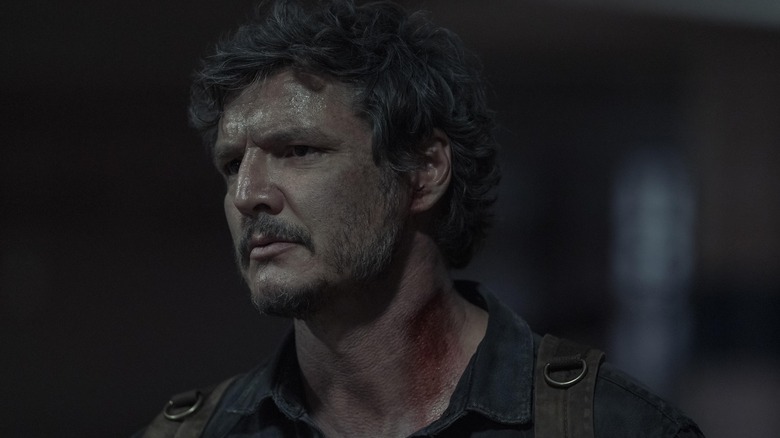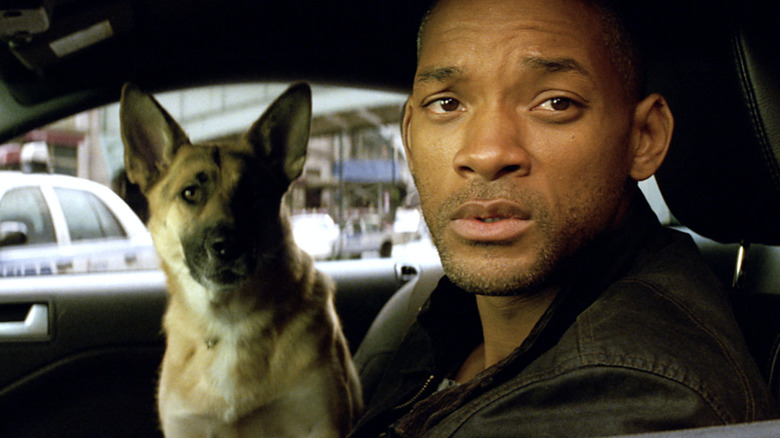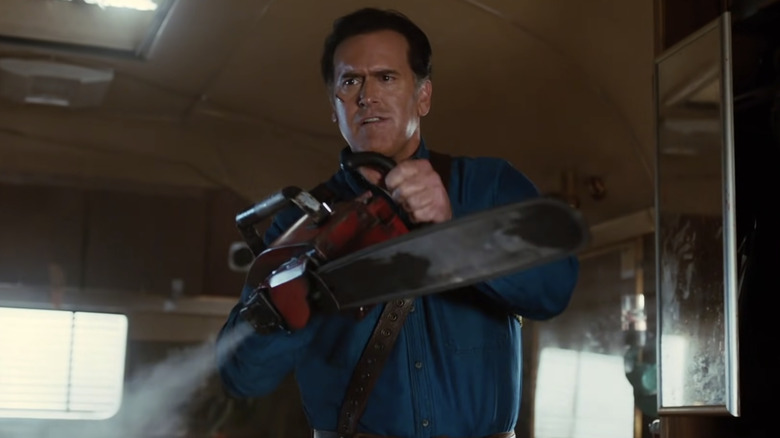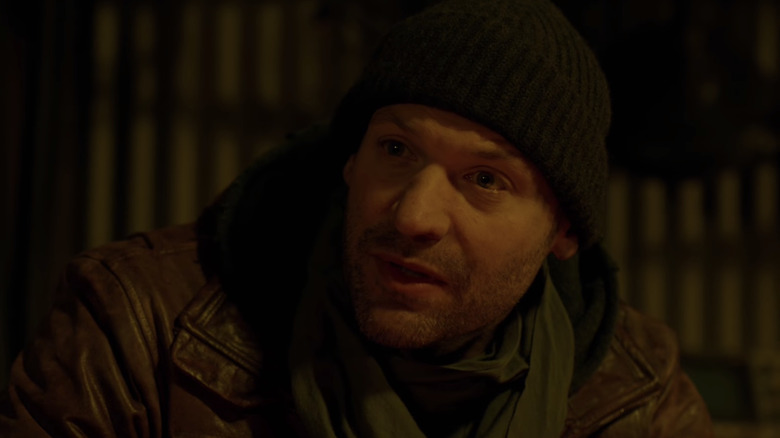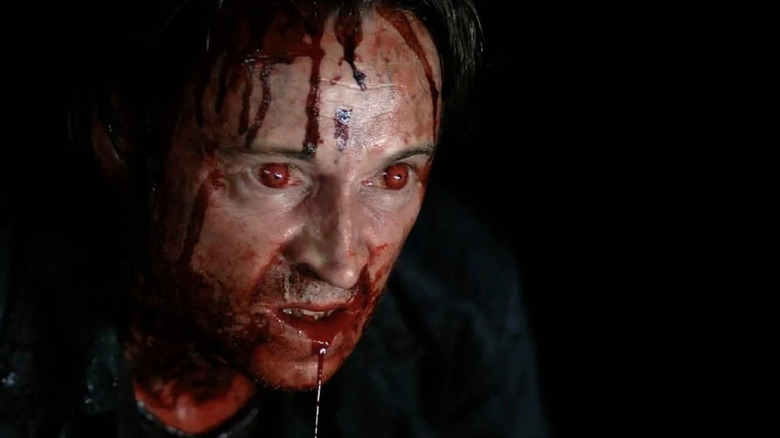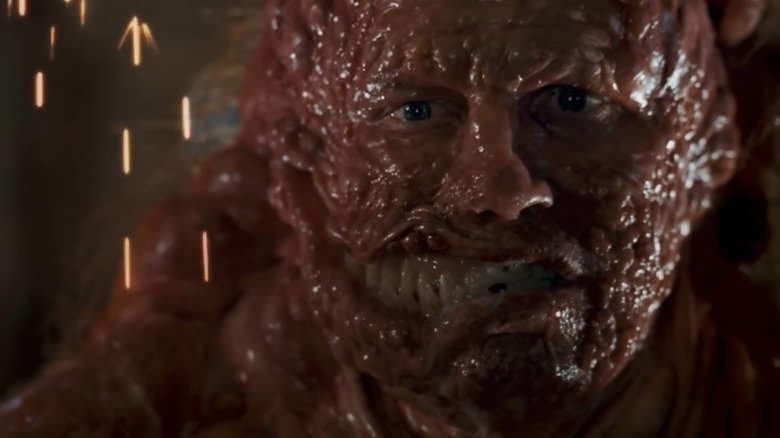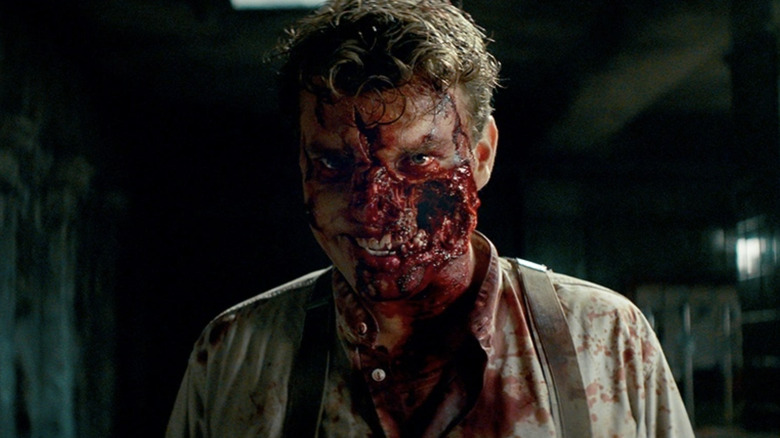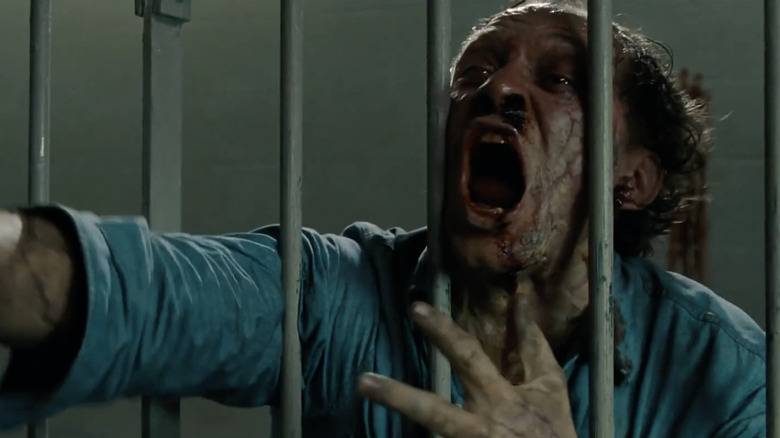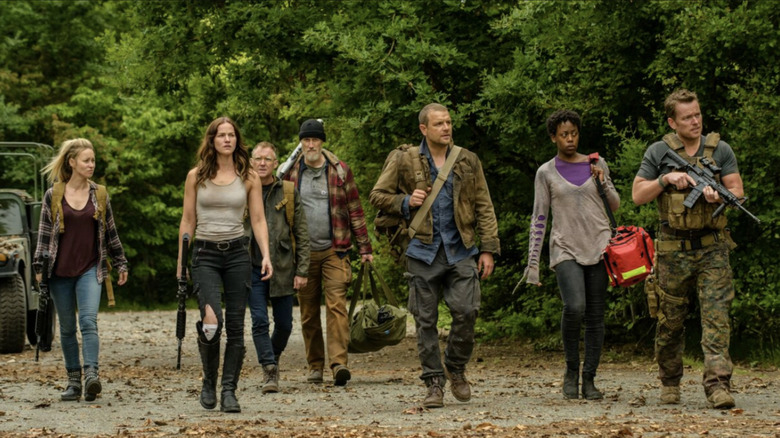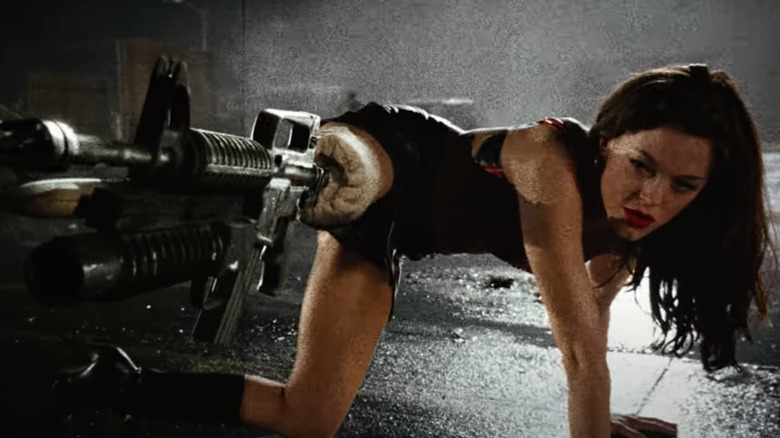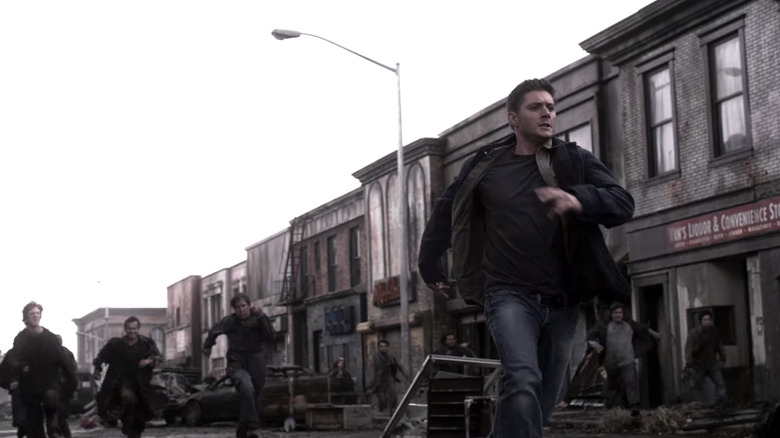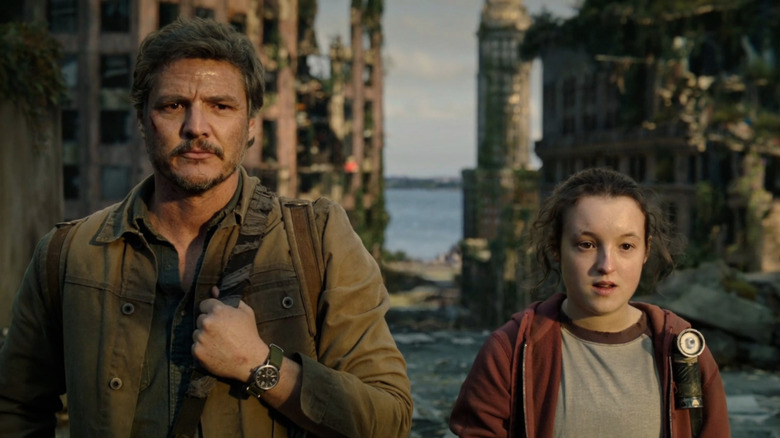11 Post-Apocalyptic Shows And Movies Where The Creatures Aren't Actually Zombies
Who doesn't love a good post-apocalyptic tale, especially when zombies are involved? Admittedly, the zombie genre is a bit overplayed, especially after the gigantic success that was AMC's "The Walking Dead." The iconic comic-turned-television series seemingly spawned more offspring than a horde of walkers, including multiple spin-offs, video games, comics, novels, and more. Not to mention countless imitators who hoped to capitalize on the success of the newly reborn undead genre (here's looking at you, "Z Nation").
Of course, not every major post-apocalyptic movie or show features zombies exclusively. Some deal with global power outages, nuclear war, climate change, and other external factors that cripple the world. Nevertheless, it's hard to argue that the best usually feature some sort of monster; there are plenty of zombie-adjacent post-apocalyptic (and simply apocalyptic) stories out there, but just because they may look or act like zombies doesn't mean they're actually the undead.
Shows like "The Last of Us" and movies like "I Am Legend" introduce viewers to different ideas of what a zombie apocalypse, or more accurately a post-apocalyptic world, might look like if those responsible didn't literally crawl out of their graves. While a good zombie movie is hard to beat ("World War Z" was pretty great, after all), there's no doubt that some of the most unique and compelling zombie-like tales come from movies and shows that avoid classic portrayals of the undead in favor of something more interesting. Below, a (spoiler-heavy) breakdown of the best.
I Am Legend
Based on the Richard Matheson novel of the same name, "I Am Legend" is the third adaptation of the original source material, and possibly the most beloved. After "The Last Man on Earth," which was co-written by Mattheson and starred Vincent Price, and "The Omega Man," which starred Charlton Heston, this version, which stars Will Smith as Dr. Robert Neville, the last man in New York City and the only man working on a cure for this deadly virus. It's a lonely existence, for sure, but it doesn't take long before viewers see that Neville isn't really alone.
Though the novel itself, which was released in 1954, reinvigorated the then dying zombie and vampire genres, the monsters seen in Smith's "I Am Legend" aren't either. Instead, these albino, light-sensitive mutants are their own sort of creature, blending vampire hallmarks such as an aversion to light with the zombie horde mentality to create a truly terrifying creature. But more than that, these things are intelligent, and they set a trap to draw Neville out and capture him alive after he took one of their own.
This adaptation of the beloved Mattheson classic is one in a million, and with a sequel on the way (which reportedly follows the controversial alternate ending rather than the theatrical), there seems to be more adventures to come. Maybe one day, there will be a more faithful adaptation to the source material — but until then, Smith's version is pretty great.
The Evil Dead/Ash vs Evil Dead
While "The Evil Dead" isn't strictly post-apocalyptic, it is certainly apocalyptic in nature, especially if the Deadites ever succeed in taking over. While the original Sam Raimi horror flick is great on its own, "Evil Dead II," "Army of Darkness," 2013's "Evil Dead," and "Ash vs Evil Dead" all contribute nicely to the franchise. By now, almost everyone associates "The Evil Dead" with your standard zombie horror flick, and while there are certainly some enormous similarities, the Deadites in the "Evil Dead" series are actually demonically possessed human beings.
That's right, these parasitic demons feast on humanity (as well as other living things) by taking over via bites, scratches, spells, and other violent "touches of evil." Like most zombies or demon-possessions, Deadites change the appearance of their hosts, giving them ghoulish features. Unlike the classical undead, Deadites can be saved, usually by sunlight, magical totems, or "the power of love," ala "Evil Dead II." Yes, they've even been known to possess corpses from time-to-time.
While the "Evil Dead" movies are well-worth your time — and there's a new standalone feature coming out — "Ash vs Evil Dead" is the real MVP of the series. Taking place decades (well, centuries really) after Ash Williams' (Bruce Campbell) adventure in "Army of Darkness," he arms himself once again in the fight against demonic evil. It's a very bloody good time if you love apocalyptic zombie stories that, well, aren't actually about zombies.
The Strain
Based on the novel trilogy co-authored by Guillermo del Toro and Chuck Hogan, FX's "The Strain" is a horror drama that covers a dark world where a viral outbreak begins turning folks into vampires. As these ghoulish undead creatures begin to take over the world, the CDC's Canary Project, led by Dr. Ephraim "Eph" Goodweather (Corey Stoll) fight for a cure. Like any good post-apocalyptic or zombie series, "The Strain" relies heavily on the monsters while also creating complex interpersonal conflicts to keep folks interested.
Running for four seasons, the series featured some pretty fascinating takes on vampires, and drew some interesting lines between classic vampirism and the viral strain that attempts to mimic it. Admittedly, the vampires in "The Strain" aren't too much like zombies (apart from occasionally looking the part), and the grotesque way in which they spread their infection — via elongated tongues that protrude from their mouths — is unlike anything seen before. Yet, the series feels like a zombie-infused world, making it all the scarier.
Though del Toro only co-wrote and directed the pilot, his vision is clear throughout the series, and thankfully Hogan stuck around to see the show through, earning writing credits on 13 episodes over the course of the series run, including the series finale. For most zombie fans, "The Strain" may be a bit of a departure from the usual, not unlike "I Am Legend," but if you're only looking for zombie-ish stories, then this one's for you.
28 Days Later/28 Weeks Later
Predating Rick Grimes' iconic "waking up in the apocalypse" intro from "The Walking Dead" comic series by only a year, "28 Days Later" is known for reinvigorating the zombie world, breathing, well, not very fresh air onto the slowly decaying husk that was the subgenre. Starring Cillian Murphy as Jim, a bicycle courier who awakens from his coma into a world unlike anything he knew before, he's quickly confronted with a series of rabid humans infected by the "Rage Virus." Though it's easily mistaken as one, director Danny Boyle does not consider "28 Days Later" a zombie movie, and for good reason.
Though the Rage-infected are zombie-like in that they claw and scrape and consume human flesh, these not-zombies can die like any normal human, including by starvation. As the film concludes, Jim notes this after hearing a news report on television. Likewise, in the 2007 sequel "28 Weeks Later," Don (Robert Carlyle) shifts almost instantaneously from his normal self to a rage-fueled beast, a process that usually takes a bit more time for zombies. Beyond that, while infected, Don continues to have flashbacks to his life before, making these Rage-monsters a bit more unique.
While a sequel, "28 Months Later," has been rumored since the release of the first sequel, it wasn't until 2019 that the film was reportedly in development, with Boyle returning to direct (via The Independent). Here's hoping that even as the virus has spread, there is still hope for a cure.
Slither
James Gunn's strange directorial debut, "Slither" is a pretty disgusting body horror flick that — like John Carpenter's "The Thing" before it — pulls out all the stops to make an alien parasite into a deadly, disturbing creature. But unlike "The Thing," the monsters of "Slither" are a bit more like the walking undead, complete with decaying skin, some serious bloodlust, and the classic slow walk and growl. As these alien parasites slither their way into the homes, halls, and eventually bodies of the good people of Wheelsy, South Carolina, the consequences are disastrous.
While the whole world doesn't devolve into a post-apocalyptic madhouse, Wheelsy sure does, and quick. As Police Chief Bill Pardy (Nathan Fillion) and Starla Grant (Starla Grant) fight to discover what's happening to their town, Starla's now-infected husband Grant (Michael Rooker) slowly turns everyone in town into his own little alien zombie puppet. Yes, this movie's pretty gross, and it's got some real teeth to it, but it's some of Gunn's finest work in the genre — and that's saying something, since he wrote Zack Snyder's "Dawn of the Dead" remake prior to this.
While alien parasites aren't much like zombies on paper, in practice they act more-or-less the same, though they're a bit more competent than your average walking corpse. Combined with solid performances from Fillion and Banks, "Slither" is a must watch for any fan of the zombie subgenre, or anyone who loves Gunn's greater body of work.
Overlord
Some of the best zombie-not-zombie stories take place in the midst of an apocalypse, and there's no greater real-world apocalypse (at least in modern day) than World War II. Produce by J.J. Abrams, "Overlord" takes place during the height of the Second World War, and follows a unit of U.S. Army soldiers as they stumble upon an occupied French town that hosts a series of ungodly Nazi experiments behind closed doors. As you'd expect, the unit is soon pit face-to-face with some terrifying Nazi monsters, including members of their own unit.
What makes the monsters of "Overlord" particularly frightening is that these Nazi test subjects are mutated into nearly unkillable foes by a mythical black tar-like substance that runs beneath the small town. This, combined with the scientific advancements of the time, make the mutants all the more dangerous, able to lose copious amounts of blood and body parts (with seemingly little pain) before dying. As Corporal Ford (Wyatt Russell), Private Boyce (Jovan Adepo), and Chloe (Mathilde Ollivier) fight to stop these experiments, things get way out of hand.
Though "Overlord" could've easily been a misfire, the film is a good time, featuring some wonderful performances alongside its unique and twisted plot. Not only that, but the action sequences are phenomenal, and will make you wish this one ran just a bit longer. Zombies or not, these mutated Nazis and townsfolk are formidable threats to be sure, easily some of the scariest monsters in recent post-apocalyptic fare.
The Crazies
There's more than one version of "The Crazies," the first from George Romero and a remake by Breck Eisner, starring Timothy Olyphant and Radha Mitchell as leads Sheriff David and Dr. Judy Dutton. Surprisingly, this version of "The Crazies" marks a rare instance, especially in horror, where the remake is better than the original.
In a small town (rural Pennsylvania in the original, Iowa in the remake), people begin committing seemingly random acts of murder. As it turns out, this behavior is caused by a biological weapon, a virus called Trixie, which infects the townsfolk through the local water supply after an accident. While the "crazies" all act pretty zombie-like in their ravenous ways, and some show visible zombie-ish signs of infection, they're not undead at all. Rather, these people are still alive, and can be killed just like any other.
But, the fact that the Trixie-infected are alive makes them all the more dangerous. They retain their normal motor functions, and while their social skills are a bit off, they're shown to be capable of thought and even regular, verbal communication. Some of them, as seen at the end of the remake, even seek out revenge. "The Crazies" is not one to sleep on.
Van Helsing
Not to be confused with the Hugh Jackman blockbuster of the same name, "Van Helsing" opens in a post-apocalyptic Seattle where the world has gone to hell-in-a-handbasket. After the supervolcano below Yellowstone national park blew, the world was covered in darkness. This triggers "The Rising," an event where vampires, who had lived underground for centuries, ventured back into the world and revealed themselves to humanity. After dying herself, Vanessa Van Helsing (Kelly Overton) wakes up in a post-Rising world and pairs herself with a group of survivors to make it through.
While the vampires seen in "Van Helsing" are technically undead, they're not zombies. They act like zombies, and they even eat through human flesh like your average "Walking Dead" walker, but they're vampires to the core. Though there's some debate on whether these creatures originated via virus or magic (or maybe some combination), "Van Helsing" is a show that loves to play around with both. It shares some similarities to "The Walking Dead," especially initially, but this undead post-apocalypse series is so much more, and builds itself a vast mythology to go along with it.
Besides the vampire lore itself, which is particularly interesting, Vanessa, Axel Miller (Jonathan Scarfe), and the gang are a compelling group to follow, especially the longer you join them. Vanessa in particular has some serious surprisingly dark ties to the underworld below. Plus, Christopher Heyerdahl's Sam is probably the scariest undead monster out there — he'll undoubtedly give you nightmares.
Planet Terror
Originally released as the first half of a double-feature by Robert Rodriguez and Quentin Tarantino, "Planet Terror" found new life on its own apart from the "Grindhouse" label. Rodriguez's "zombies" don't technically fit the zombie bill; called the "Sickos," they aren't undead. Rather, these are people who — like in "The Crazies" — have simply been infected by a virus that makes them uber-violent.
Likewise, the Sickos all still hold their previously learned motor functions, can be cured from the disease, and even retain their personalities when infected — which sort of makes their demise a bit problematic when you think too hard about it. But, that's sort of the point of "Planet Terror"; don't think too hard about it, just enjoy the show. Headlined by Rose McGowan, Freddy Rodriguez, Michael Biehn, and Josh Brolin, this one is way out of the box, which is exactly its appeal.
Armed (or, is it legged?) with a machine gun for a right leg, McGowan's Cherry Darling takes these hordes of monsters head-on and jumps head-first into the fire. Not only does she survive to the end, but she manages to take out a whole host of Sickos in the finale sequence. Break a leg, indeed.
Supernatural
This one might be a bit of a cheat, but since "Supernatural" tackled just about everything over 15 seasons, they'd naturally tackle the zombie apocalypse too. But the zombies that Sam and Dean Winchester (Jared Padalecki and Jensen Ackles) faced came in all different shapes and sizes. Some were the direct spawn of demonic or magical viruses, while others were more akin to the traditional undead.
The show's most notable "not-zombies" first appeared in Season 2's terrifying "Croatoan." These ordinary people contract a demon virus, called the Croatoan Virus, which traces back to the missing Roanoke colony. While seemingly normal at first, these folks transform into violent, rage-fueled monsters who stop at nothing to spread it further. In Season 5's "The End," Dean is transported to a post-apocalyptic future in which the devil has taken over. Here, he's chased by a horde of "Croats" in a very "Walking Dead"-like opener, and though he doesn't beat the devil, this experience propelled the Winchesters to eradicate the Croatoan Virus once and for all in "Two Minutes to Midnight."
Beyond these not-zombies, Season 7's "How to Win Friends and Influence Monsters" revealed certain foods provided by the otherworldly Leviathans turn average people into somewhat brainless, zombie-like rage monsters over time. Apparently, you really are what you eat. Counting more traditional zombies, there are 15 "Supernatural" episodes alone that feature the enraged, flesh-eating undead.
The Last of Us
HBO's "The Last of Us," much like the pandemic seen on the series, quickly became a global phenomenon. This not-zombie series follows the adventures of Joel Miller (Pedro Pascal) and Ellie (Bella Ramsey) as they venture from Boston to the desolate American West to get Ellie to the Fireflies, a group searching for a cure. Speaking of the virus, this isn't some airborne pathogen or magical curse, the zombies seen in this series come from a fungal infection that quickly crippled the world.
Based on the 2013 video game of the same name (and its subsequent remakes and sequels), "The Last of Us" looks like any zombie-infested post-apocalyptic world on the surface, with many of the same trimmings and trappings, but it's so much more. These infected are part of a larger hive-mind connected deep underground through roots systems that link these plant-people together. Likewise, the fungal infection can mutate differently in various people, producing different versions of the creatures.
But besides the show's unique take on the apocalypse, it is the Joel and Ellie dynamic that keeps viewers invested. This surrogate father-daughter duo go through all kinds of hell, continually, improbably managing to make it out the other side. With a stellar first season under its belt, and another on the way, "The Last of Us" has more stories to tell, even if they don't involve zombies.
